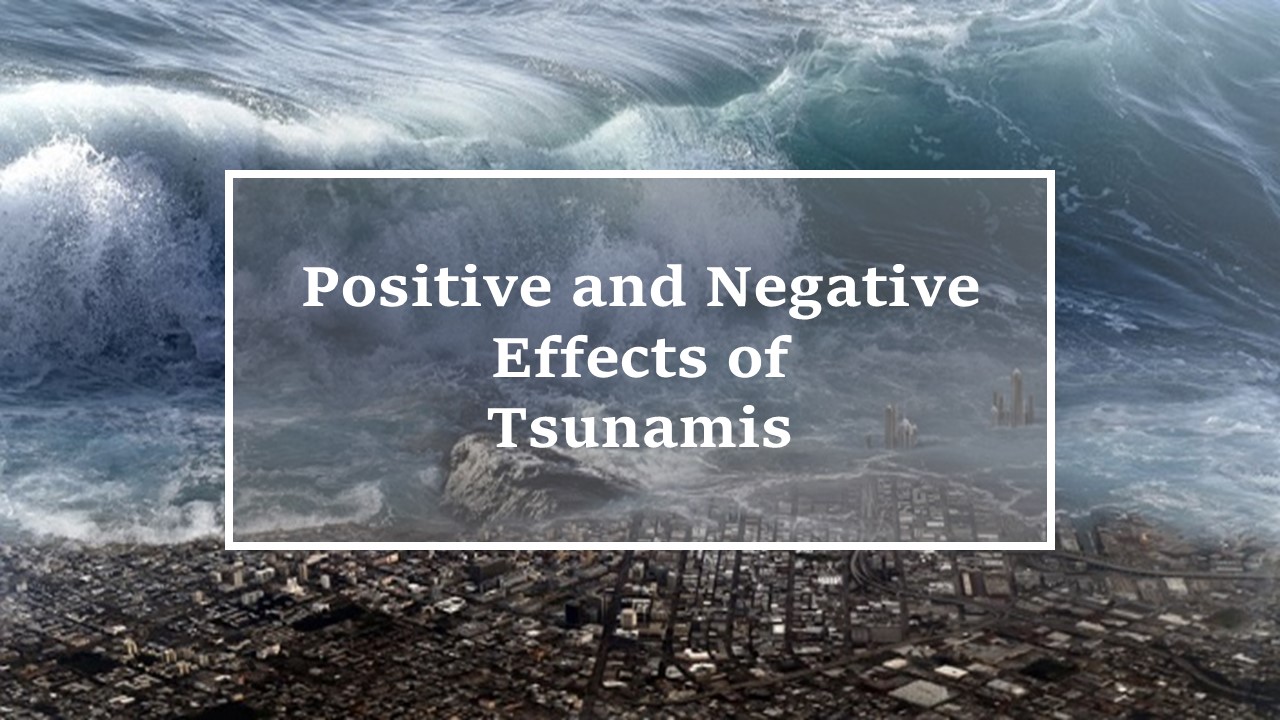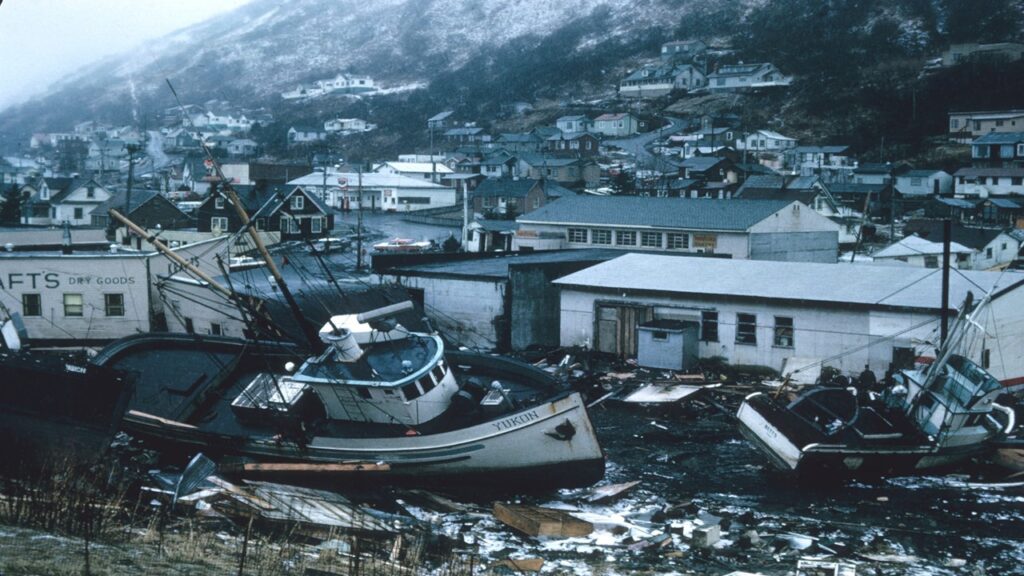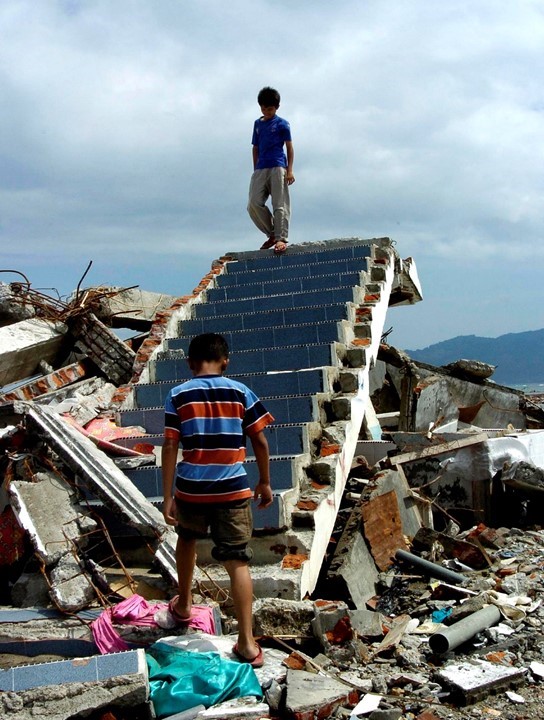Effects of tsunamis: Positive, Negative, Examples

Effects of tsunamis can be both positive and negative.
The word tsunami typically rhymes with fear. And for good reason. Giant tsunami waves can elevate from the ocean without warning and wash away everything along their paths. Yet, as catastrophic as tsunamis can be, they also have some good effects.
Earliest records of tsunamis
Interestingly, the earliest accounts of tsunami events date to 4000 B.C. in China. However, the first tsunami was described and recorded in the Mediterranean, off the coast of Syria, in 2000 B.C. In fact, out of the 23 historical tsunami records for the B.C period, a large part happened in the Mediterranean. This is because humans have inhabited this part of the world since ancient times.
Conversely, little documentation on tsunami-prone regions that we know of today actually exist. For instance, Hawaii is a sentinel for events in the Pacific Ocean. However, tsunami records start only as from 1813. Likewise, evidence for tsunamis in Alaska emerges as from 1788 while few records exist for the USA.
Positive effects of tsunamis
As absurd as it may sound, tsunamis indeed provide some good benefits. In the Pacific Ring of Fire for instance, where most of the world’s tsunamis occur, these hazards played an important role in the ocean’s history. From providing food to big mammals to shorebirds, tsunami waves connect distant countries such as Hawaii and Alaska. In the past 500 years, tsunamis coupled to other oceanic currents conceived the intricate marine system in the Pacific.
In general, the positive effects of tsunamis include the redistribution of nutrients in coastal regions, the creation of new habitats, landscape changes, provision of new economic opportunities and study opportunities.
Redistribution of nutrients
Perhaps one of the most important positive effects of tsunamis is a redistribution of nutrients. Tsunamis waves can lift up nutrient-rich sediment in estuaries and deltas and disperse it inland. In so doing, tsunamis help to spread nutrients in agricultural areas thus increasing the fertility of the soil.
What’s more, as the giant tsunami waves crash on the coast, they also distribute water inland. Sometimes, they can inundate dried out ecosystems like mangroves and marshes. In this way, they help to restore ruined habitats.
At the same time, tsunami waves help in distributing nutrients in the ocean as well as animal species. To illustrate this, the amount of nutrients in the Malacca Strait near Sumatra and the Bay of Bengal after tsunami events increased by 3 to 5 times. Likewise, tsunami waves help in propagating small animal species from one region to another.
Create new habitats
In the same vein, tsunamis can also create new habitats. For example, plants can eventually grow in the nutrient-rich sediment that tsunami waves brought to the lowlands. Over time, jungles can form where animals can also find refuge. In fact, very often, researchers discover that tsunamis create new habitats or even increase the diversity of certain species.
The tidal marsh sedge, Carex regulosa, illustrates this case very well. This near-threatened plant species grows in brackish sandbars in Japan and is easily outcompeted by terrestrial plants. Researchers found that the 2011 tsunami event created more sandbar habitats along the Japanese coast. Sedges colonized these habitats forming more intense populations.
At the same time, the species diversity of the marsh sedge also increased. Here, the researchers presume that the tsunami brought seeds buried in the sand to the surface. The seeds eventually germinated and formed new populations of sedges.
Tsunamis create landscape
A more common impact of tsunamis is that they create new landscape. As the giant waves crash on the shore, they can produce some dramatic features in the landscape. Tsunamis can either deposit large amounts of materials on the shore or wash away chunks of rocks and sand.
Thus, as tsunamis deposit materials on the shore, they form sand laminae, dump deposits, ridges, mounds and boulder stacks.
Conversely, the impact of tsunami waves on the coast can wipe out coastal forests, create grooves, potholes and leave impact marks. Additionally, ramps, canyons, pools, cascades, sea caves, arches, whirlpools, raised platforms and truncated cliffs can also form.
New economic opportunities
Now with more people living in coastal regions despite the associated dangers, there is a need for tsunami resistant buildings and infrastructure. Architecture and engineering firms can thus provide these solutions. They can provide materials like stilts to resist tsunami waves or come up with innovative ideas.
Study tool
As it is, tsunami events provide insightful study opportunities, be it to increase resilience or to understand the hazard itself. It is in fact thanks to tsunami signatures that now we know so much on past events like asteroid impacts on Earth. In the same manner, tsunamis allow researchers to better understand certain topics like island stability, coastal morphology and ecological succession.
For example, low lying atoll islands are typically seen as vulnerable to sea-level rise and tsunamis. Yet, these atolls are quite stable to oceanic furies. So, some researchers studied 13 atolls on the Maldives after the 2004 Indian Ocean tsunami. They noticed very little erosion and decrease in land area. Hence they concluded that atoll islands are physically robust despite their low position in the sea.
Negative effects of tsunamis
Coming to the negative effects of tsunamis, they are generally divided into primary and secondary effects.
Primary effects of tsunamis
Primary effects refer to the impacts that tsunamis have as they hit the coast and reel back to the sea. Thus, the primary effects of tsunamis include damage to properties, deaths, erosion and other in changes in the landscape. What is often left is bare ground or covered with all sorts of natural and human-made debris.

Secondary effects of tsunamis
Conversely, secondary effects of tsunamis take place hours, days and weeks after the event. It can include fires, explosions, pollution from sewer networks and carcasses and disease outbreaks. Sometimes, the secondary effects can be worse than the triggering tsunami event itself.
Nevertheless, generally speaking, tsunamis damage buildings and infrastructure, lead to loss of lives and social disruption, cause economic losses, and damage ecosystems.
Damage built infrastructure
Basically, tsunamis can damage everything across their paths. As the giant waves break inland, the force of the impact can destroy buildings, infrastructure, and communication lines. They can also disrupt transportation networks thus hampering the movement of goods and relief workers. Where infrastructure is poorly built, tsunamis can be quite destructive.

Nonetheless, sometimes even the most prepared nations can suffer greatly from these natural hazards. For instance, Japan often faces earthquakes and tsunamis. Thus, to mitigate the effects of tsunamis, in 2009, the government erected the Kamaishi seawall outside of Kamaishi. The majestic wall worth billions stood 6 m high above sea level. Yet, the tsunami waves of 2011 overtopped this great wall and destroyed it.
Loss of lives and social disruption
Unfortunately, tsunamis often hit without warning. By the time people see the giant waves, it is too late to escape. In general, a large part of tsunami-related deaths occurs due to flooding. As the waves wash inland though, they damage buildings, vehicles and infrastructure causing more deaths. The 2004 Indian Ocean tsunami killed around 230,000 people in 17 countries.
And if some people remain alive, sometimes it is with chronic injuries. As buildings and infrastructure collapse, they can injure people at times even leading to lifelong infirmities. What’s more, very often, victims can develop psychological problems after such events. Children and adolescents especially can be traumatized as they lose their loved ones during these devastating events.
Economic losses
It goes without saying that tsunamis can incur considerable economic losses. The devastating Indian Ocean tsunami event alone resulted in economic damage of US $ 9.4 billion. Aceh, Indonesia, the main victim, had economic damage of US $ 4.5 billion or the equivalent of its GDP in the previous year.
As the giant waves sweep across an area, they damage residential, commercial and agricultural facilities. All sectors of businesses can be affected from human resource to transportation networks. What’s more, tsunamis can severely damage agricultural production from polluting the land to wiping out harvests. Or, they can lead to the spread of diseases in livestock populations.
For countries that rely heavily on coastal tourism, such as the Pacific Islands, tsunamis can rupture the entire economy.
Damage ecosystems
In the same manner, as tsunami waves travel to and from the ocean, they damage both terrestrial and oceanic ecosystems along the way. Following the Indian Ocean tsunami, Indonesia recorded 30% of coral reefs and 20% of seagrass beds as damaged.
As the waves return to the sea, they can transport and deposit terrestrial sediment on coral reefs. This sediment can in turn cause coral polyps to die. Alternatively, when the waves crash inland, the force of the impact can damage coastal ecosystems. They can also throw sediment and debris into rivers and estuaries.
Yet, more dangerously, the high waves can flood small offshore islets where animals like birds and reptiles breed. For example, the 2011 tsunami event off Japan killed over 110,000 Laysan Albatross chicks on the Midway Atoll National Wildlife Refuge. The waves also reached the Galapagos Islands and killed some marine iguanas.
References
- Manning, W.J., 2005. TSUNAMI: Disconnect and the Aftermath. TheScientificWorldJOURNAL, 5.
- Armitage, D. and Bashford, A., 2016. Pacific Histories: Ocean, Land, People. Asian Review of World Histories, 4(1), pp.168-172.
- Haldar, D., Raman, M. and Dwivedi, R.M., 2013. Tsunami-A jolt for Phytoplankton variability in the seas around Andaman Islands: a case study using IRS P4-OCM data.
- Ohbayashi, K., Hodoki, Y., Kondo, N.I., Kunii, H. and Shimada, M., 2017. A massive tsunami promoted gene flow and increased genetic diversity in a near threatened plant species. Scientific reports, 7(1), pp.1-9.
- Bryant, E., 2014. Signatures of tsunami in the coastal landscape. In Tsunami (pp. 35-61). Springer, Cham.
- Kench, P.S., McLean, R.F., Brander, R.W., Nichol, S.L., Smithers, S.G., Ford, M.R., Parnell, K.E. and Aslam, M., 2006. Geological effects of tsunami on mid-ocean atoll islands: The Maldives before and after the Sumatran tsunami. Geology, 34(3), pp.177-180.

Pingback: Volcanic Eruptions: Positive and Negative Effects - Yo Nature
Pingback: Why islands must protect their mangroves - Yo Nature